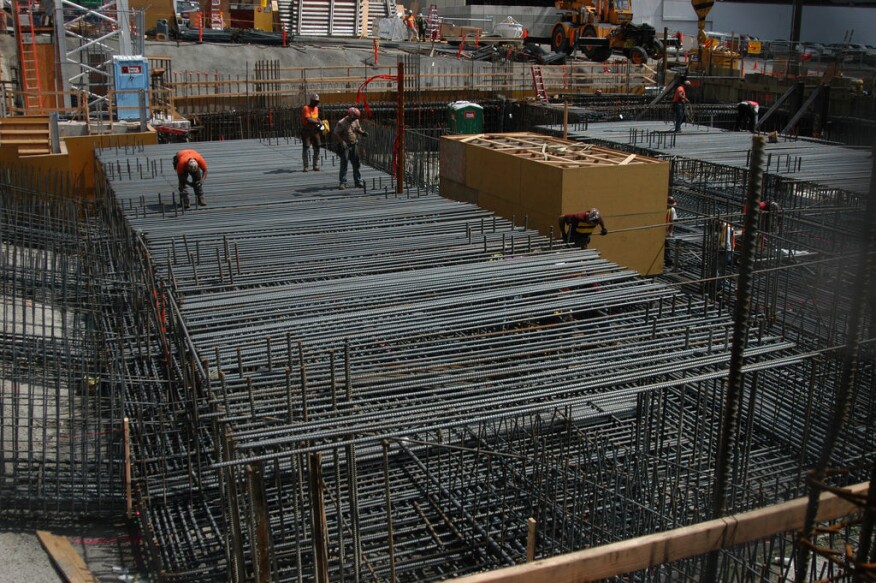
Concrete is the world’s most common building material and the second-most consumed substance after water. In particular, steel-reinforced concrete dominates the AEC sector, where its combined resistance of tensile and compressive forces enables the construction of tall and long-span structures. Despite its near-ubiquitous use, however, steel-reinforced concrete has a fundamental drawback: Given the corrosive tendencies of ferrous metals, it is at best a temporary material, requiring constant upkeep. In Concrete Planet: The Strange and Fascinating Story of the World’s Most Common Man-Made Material (Prometheus Books, 2011), author Robert Courland writes: “If the Romans had used steel-reinforced concrete—which they did not have—to build their beautiful bridge in Alcántara, Spain, the bridge would have to have been rebuilt at least 16 times by now.”
Steel reinforcing bar, or rebar, has an intrinsic tendency to deteriorate, which led the National Bureau of Standards (now the National Institute of Standards and Technology) to conduct the first comprehensive corrosion research in the early 1970s. The agency concluded that epoxy-coated reinforcing would perform better than unprotected steel. Today, this form of reinforcing is the most prominent corrosion-resistant steel used in North America; other protected reinforcements included galvanized steel, stainless steel, and glass fiber–reinforced polymer. However, new research offers two compelling non-corrosive alternatives.
The first is a variant of continuous basalt fiber (CBF). Developed in 1923, CBF is made from the dense and abrasion-resistant igneous rock. By the 1960s, it had found use in a variety of applications in the U.S. and the former Soviet Union, according to the trade publication CompositesWorld. CBF exhibits 2.5 times the strength-to-weight ratio of alloyed steel and 1.5 times that of glass fiber. Most importantly, it does not corrode like metal and, unlike glass fiber, it is not subject to deterioration from acids. CBF is also inherently fire-resistant and can be used with various composites, CompositesWorld reports.
ReforceTech, in Norway, has developed a novel version of CBF. Reinforced with basalt fibers, the company’s 0.5- to 10-millimeter-diameter BFRP MiniBars are composed of fibers wrapped with polymer resin in a helical shape and can span from 20 millimeters to 200 millimeters in length. The bars are mixed directly into the concrete without impairing its workability, the company says, reducing or altogether eliminating the need for steel reinforcing. Moreover, contractors do not need to consider the exact positioning of the rebar and the miniature bars do not protrude from the finished concrete surface.
When used in precast architectural cladding, ReforceTech’s basalt fibers not only eliminates the need for rebar but also significantly reduces panel thickness. “We already have precasters in Europe making insulated wall panels where the exterior wythe is down to 1.5 inches from the older 3-inch thickness,” said Alvin Ericson, a technical consultant at ReforceTech, in an email. “This reduces the amount of concrete, the weight of the panel … and allows for increased insulation and/or floor area.” Unlike steel, CBF is not thermally conductive, allowing it to connect inner and outer layers of insulated wall panels without thermal transfer concerns.
Engineered bamboo is also being explored as a rebar alternative. Early tests of thin bamboo specimens in concrete began at MIT in 1914. In the following decades, researchers at the Technische Hochschule Stuttgart and the Clemson Agricultural College of South Carolina (now Clemson University) have devised more elaborate tests. Despite bamboo’s high tensile strength, Clemson professor H. E. Glenn determined, in 1950, that its susceptibility to decay from moisture, insects, and fungus, and dramatic shrinking and swelling were fundamental material drawbacks. After recording dramatic structural failures that year due to de-bonding between the bamboo and concrete, research on bamboo reinforcement waned.

Testing has resumed in recent years at the Future Cities Laboratory (FCL) in Singapore, based this time on the use of woven-strand bamboo (WSB)—a composite material developed in southern China that resists moisture absorption, swelling, and decay from bacteria and fungi. Also used in flooring, WSB is made by slicing skinned bamboo stalks lengthwise into thin strands, which are carbonized and dipped into a vat of water-based adhesive before being either hot- or cold-pressed in molds. The resulting composite products exhibit three times the density of the natural bamboo.
Such tests show promise. The FCL team, led by architecture and construction chair Dirk Hebel, found the WSB manufacturing process to eliminate many of the previous limitations of bamboo reinforcing in concrete. His team is now developing specifications for an alternative WSB manufacturing process that reduces potential damage to bamboo fibers. “This is in contrast to the furniture and flooring industry in China,” Hebel wrote in a recent article, “where the individual fiber or cell is not of interest at all and is usually destroyed through [the] carbonization processes to eliminate all natural sugars in the bamboo material and therefore be unattractive for fungi and bacteria.” Hebel’s team is also analyzing the structure of individual bamboo fibers and their interaction with various adhesives through a process called confocal fluorescence microscopy.


Using WSB to reinforce concrete has many advantages. Bamboo is rapidly renewable and sequesters carbon, as opposed to the energy- and carbon-intensive steel. Additionally, bamboo is a highly accessible resource in rapidly developing regions like Southeast Asia where, Hebel writes, “the potential for bamboo composite materials, considering all areas of bamboo coverage, currently is 25 times higher than today’s demand for construction steel.”
Though conventional steel rebar isn’t going anywhere yet, the long term is less certain. Steel’s intrinsic corrosive tendencies point to decades of costly maintenance, and its high embodied energy yields a poor environmental scorecard. The significance of materials such as woven-strand bamboo and basalt microfiber, therefore, is not represented by their incremental successes but rather by their long-term potential to redefine the world’s most commonly used hybrid material. The result could be a brighter environmental and economic future for reinforced concrete.

















